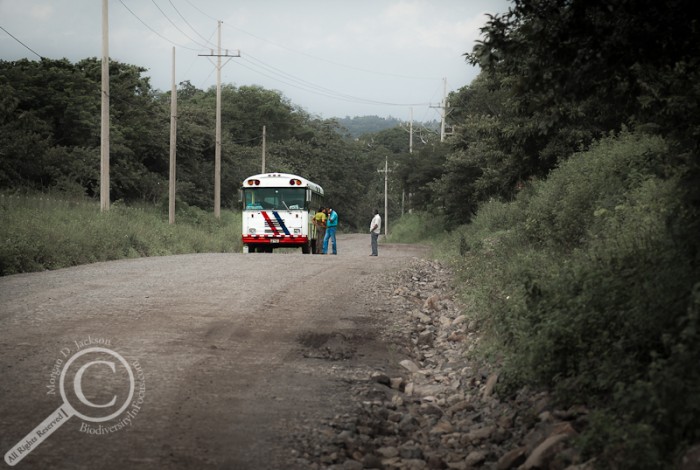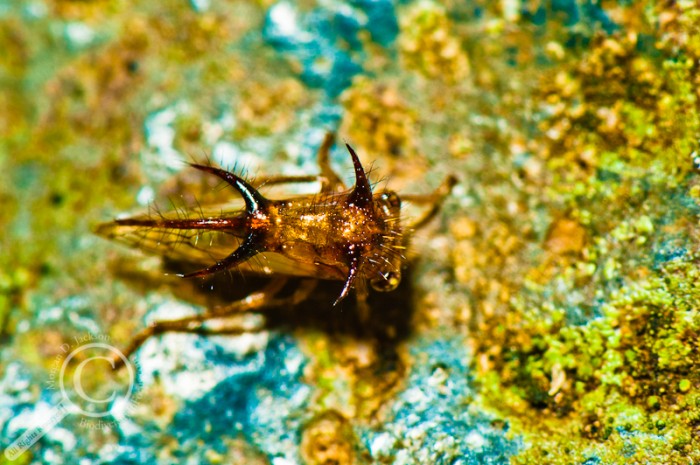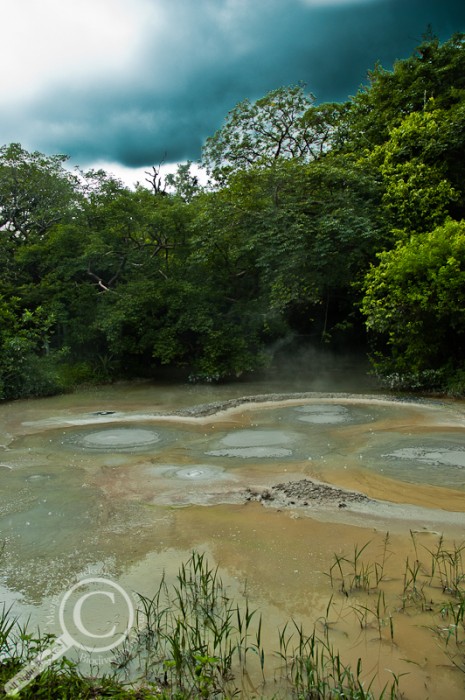“Life’s a journey, not a destination” Aerosmith
I awake in time for a hurried breakfast before the bus departs for Rincon de la Veija, our destination for the day. Rice, beans and scrambled eggs again, so I choose some toast and cereal and sit off on my own to gain a moment of solitude before another long day. We soon load onto the school bus that’s delivered many a generation of child and which will hopefully last one more trip with us aboard. Settling into my seat, or what’s left of it, and enjoying the scenery of jungles, pastures, and forested volcanoes rising up to the clouds, I ignore the growing discomfort settling in my back from the aged seat. It seems the seats are not the only components lacking functionality, with each rock and bump being translated directly from the road to my body with little dampening as we turn onto the winding road up the mountain. The grasses introduced from Africa for cattle pasture roll on and on along the sides of the volcanoes, with vultures, iguanas, and flycatchers each choosing a fence post to admire the morning sun from. As I readjust in my seat to find a scrap of padding for the umpteenth time, the bus pulls to a halt and the driver jumps out without a word. As I watch from my seat while he looks under the bus and then down the road with a puzzled look, I decide that perhaps today marks the end for this decrepit vehicle. Apparently the transport boss and our local coordinator feel the same way and it isn’t long before they’ve joined the driver looking back down the road with concerned faces. Information trickles in now that the battery has fallen out of the bus somewhere along the road, but not to worry because we’ll keep on driving. A few turns more and the bus decides that in fact we won’t keep driving, coming to a silent stop and then rolling back down the mountain before the driver applies the brakes. I can’t help but laugh at the situation, but also wonder what happens next. It seems we’re within a short walk to the outer edges of the conservation property and that a new bus will be brought in shortly to take us up to our true destination. In the meantime, they say, we can collect and explore the stream meandering its way down the volcano, a welcome and unexpected break from the mechanical chiropractor misaligning my back.
After a brief 2 kilometer hike to where the conservation area starts, I wander up the idyllic stream, marveling at how crystal clear the water is and how the shadows and sunlight dance across the surface. A mossy cliff arises from the far bank, and what looks like a hot spring seems to be seeping from beneath, creating an optical boundary and indicating that there is more to this volcano than meets the eye. As I scramble amoung the silt, eddies and boulders working my way upstream, brilliant blue morpho butterflies float above the river, their metallic wings inviting me further into this dreamlike scape. For 45 minutes I sit with boots in the river shooting the small invertebrates crawling around a large, moss and sun dappled boulder, not really caring about the shot but rather letting myself become lost in the moment. My revelry is cut short by the muffled sound of a bus horn, amazing and disappointing me with the speed with which a replacement bus was found and driven to “rescue” our party. The new bus proves to be slightly more comfortable, and the final stretch up the volcano is easily driven without further incident or loss of vital mechanics.
Pulling into the parking lot of the park we’re to explore, I’m amazed to see dozens of cars and vans awaiting the return of tourists out on the trails, the first active sign of ecotourism we’ve seen this trip. For the first time we prepare to answer questions on what we’re doing and why we don’t care about that butterfly over there. With clouds starting to form on the horizon, the group is anxious to get onto the trail, but we’re asked to watch for signs of a wayward hiker who disappeared a year ago. I start to smile until I realize they aren’t joking, and the morbid truth that the remains of the missing are more likely to be happened across by a curious dipterist wandering off the beaten path than the thousands of tourists following the trail. I make the mental note to watch my footing a little more closely today so as not to meet the same assumed fate. With the threat of rain and our earlier delay, I decide not to make the dedicated 16 km roundtrip hike to the summit and caldera, but rather explore the simpler, 3 km circular trail with the hopes of finding new specimens to take home.
From the start this trail is unlike any we’ve been on so far this trip, with outreach stations set up at points of interest for people with maps or hired guides. It’s not long before we come across several groups of tourists, from adventurous families to elderly tour groups, most ill-prepared for hiking in tropical forest and attired in short shorts, flip flops, or designer sneakers. Most don’t appear to see the forest for the trees, and I hear multiple people comment on the mud and bugs, as though they were expecting a sterile environment with cement pathways and glass to keep nature at bay. I appreciate each wanting to “experience” the wilds of Costa Rica, and their entrance fees are what maintain and expand the protected areas, but I worry about the disconnect many people must feel between the natural world and their suburb, and whether this dose of reality will continue to push them from truly becoming immersed in the beautiful complexity of the few wild places left on Earth.
We work our way along the trail, willing the sun to peek through the gathering clouds and bring the flies out of hiding. A family of crested curacao suddenly appears on the trail in front of us, and we stand and watch as they go about their business, nary a concern over our presence 10 metres away. We find a tree fall and observe reptiles, robber flies (Asilidae) and a snake all taking advantage of the sunlight flooding through the new hole in the normally dark canopy. The robber flies elude our net time and again, while the snake allows us a brief photo session before slithering back into the stump from whence it came. We’re constantly encouraged by passers-by wishing us luck in our hunt in many languages, and we reply with a smile and another attempt at those damn asilids. With the sunlight beginning to fade we move on, and join the tourists in exploring the now fly-less undergrowth and geology. Five storey waterfalls cascade down cliffs, streams cut across trails with only rounded stepping stones acting as bridges, and evidence of volcanic activity is found everywhere you look. We see natural hot springs with water boiling from thinly covered hot spots, fumaroles spouting steam and odours born in the depths of the earth, and mud pots bubbling with an ominous PLOP. We stop for lunch and watch some of our group hunting flies in the meadows of bamboo, only their hats and the occasional net visible over the reedy grass. We’re challenged by steep slopes with nothing but the roots and buttresses of strangler figs as footing, and I mentally reward all those ill-prepared tourists we’ve seen for still making it over this challenging terrain. We cross a river via a downed tree and suddenly we’re in a different habitat. A habitat kept stunted by the heat pouring up through the ground, where the boulders are hot to the touch. A habitat with small acacia bushes, grasses and flowers when the previous trail sections were composed of giant trees, ferns and mud. The afternoon rains come now, robbing us of the chance to explore this unique microclime, and I hurry the final 800m to the cover of the ranger station, concerned about my camera gear in the rain. With darker skies looming over the tree tops I retreat back to the bus, just as the brunt of the storm hits and brings heavy rains and wind with it. People flee the jungle for their vehicles and I hope the three people who headed for the summit get back before rivers swell and mud deepens. Finally the storm breaks, and the rest of our group files onto the bus, soaking wet and ready to go, but still smiling after another day’s adventure. Our return to the station was considerably less interesting than our voyage this morning, but for a few of us, our day was still only just beginning.
MTC…




[…] Discovering biodiversity through taxonomy and photography « Costa Rican Adventure – Day 16 – The Journey Part 1 […]